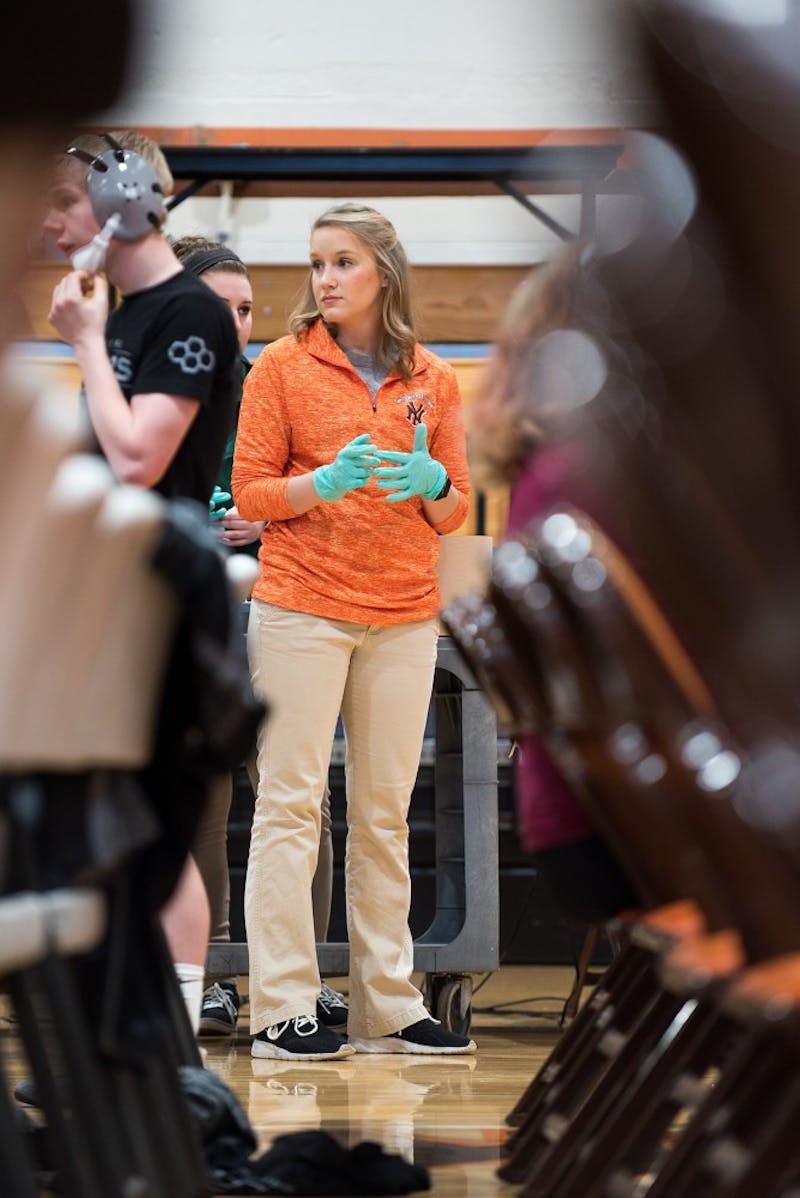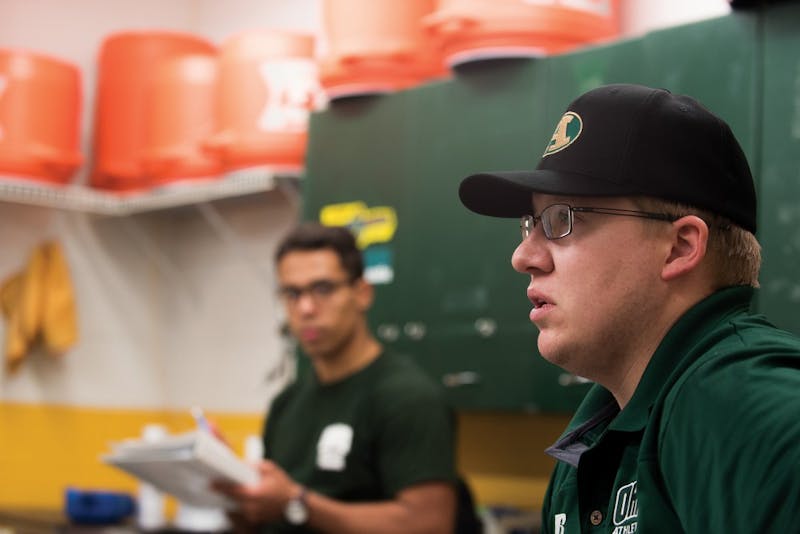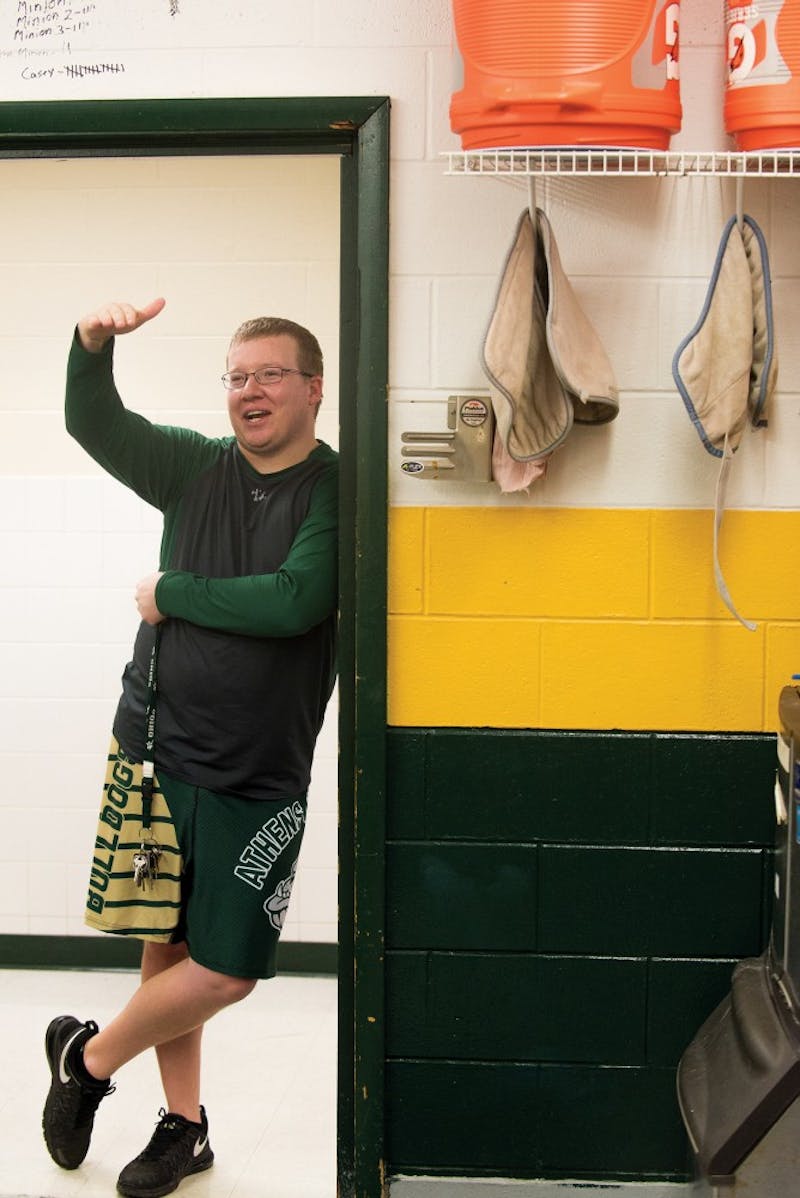Landing Page
Special Projects
This story is part of a series of specially designed stories that represents some of the best journalism The Post has to offer. Check out the rest of the special projects here.

EMMA HOWELLS
Mitch McKay, the Athens High School Head Athletic Trainer and second year graduate student, works with an Athens High School athlete to relieve the shoulder pain and tightness they have been experiencing.
08.31.16
Amidst all the commotion of a high school wrestling match, Annabelle Herron stands calm as she observes, ready to assist if needed.
She is the sole athletic trainer for Nelsonville-York High School.
Toward the end of the wrestling meet, an athlete remains on the mat, in too much pain to stand. Herron walks onto the mat and talks to the athlete for a few minutes before helping him to his knees, and then gradually to his feet.
“I am that person making the decisions, it forces me to be confident in what I'm saying and what I've learned,” Herron, who is from Westminster, South Carolina, said.
She is a first-year graduate student who is one of 45 students in Ohio University’s graduate program for athletic training. Having a college student work as a high school athletic trainer is not uncommon in southeast Ohio.
OU students in the athletic training program are able to gain educational experience in their field while providing a service to an area that lacks medical care. In several counties throughout southeast Ohio, about 11 percent of the population that is 64 years old or younger do not have health insurance, according to 2016 County Profiles from the Ohio Development Services Agency.

Emma Howells
Annabelle Herron, a first-year graduate student in the athletic training program, stands between two teams' benches, on alert for athlete injuries during a high school wrestling meet at Nelsonville-York High School on January 25, 2017.
Forty-three of the students in the graduate program have graduate assistantships in which OU provides athletic trainers to local high schools, intercollegiate athletics and campus recreation, Chad Starkey, a professor in the School of Applied Health Sciences and Wellness, said.
"All the graduate students are licensed athletic trainers which means that technically they could go work full-time any place they want,” Starkey said.
As part of the graduate assistantship, which started in 1977, 20 high schools in the area have athletic trainers. Each high school receives one athletic trainer who is a graduate student, Starkey said.
The graduate students work for 30 hours a week total. They are paid for 20 hours a week and receive academic credit for the other 10 hours a week. The stipends range from $9,000 to $13,000 for Athens-based students, Starkey said. The graduate students are paid every two weeks, and they are paid on a ten month cycle.
The paid 20 hours per week is fixed and earns the graduate student their stipend, Starkey said. During busy weeks, a graduate student may work 35 hours in total, but OU’s program ensures that is then offset with a 25-hour week, Starkey said.
“In rare cases where a student is over-worked the program intervenes on their behalf,” Starkey said in an email.
The clinical coordinator organizes the learning environment, and makes sure students stay within the hour range, Starkey said.
When a player is injured, it is up to the athletic trainers to decide if he or she can play.
"Sometimes it's hard (and) sometimes I struggle with it,” Emily Manfresca, the athletic trainer at Trimble High School, said. “I'll look at what's wrong and talk to them, obviously, and see where they are not just physically, but mentally.”
If an athlete is injured, Manfresca will modify what he or she can do, such as shooting baskets but not sprinting in practice. Manfresca, a Steubenville native, said she sometimes notices a difference between working with high school students and college athletes.
"Sometimes it's frustrating because I have to remember that they're minors,” Manfresca, a first-year graduate student in the athletic training program, said. “Sometimes you can talk to a college athlete a little differently than you can a high school athlete."
Herron is cautious when it comes to making decisions about an athlete’s injury because she is still in her first year of graduate school, she said.
“Hopefully I'll be more decisive (in the future), but … sometimes it terrifies me knowing that I'm 23 making health care decisions for these kids,” Herron said.
She said the emergency cases are easier to treat.
“The (cases) that you think you would literally just break down and freak out about, those are the easy ones because you know your steps, you know what you're supposed to do,” Herron said.
Athens High School baseball coach Chris Stewart said the athletic trainers from OU’s athletic training program have been “absolutely phenomenal.”
“They’ve all worked well with the kids and that’s one of the things that I really enjoy watching is the relationship the kids developed with (the trainers) that are still students,” Stewart said.

Emma Howells
Mitch McKay, the Athens High School Head Athletic Trainer and second year graduate student in the athletic training program, advises a student on further treatment on January 27, 2017.
Mitchell McKay, the athletic trainer for Athens High School, knows firsthand how important his job can be.
During the homecoming football game his senior year of high school in Ogden, Utah, he sustained a concussion.
“When I got tackled it was like an electrical shock straight down my head all the way to my tailbone,” McKay, a second year graduate student in the athletic training program, said. “The next thing I remember was being in the ER, finding out it was 36 hours later."
Up until that hit, McKay said he had aspirations to play football beyond high school, but that injury changed everything.
“I sustained a severe concussion … which basically made me not want to play football in college, but I wanted to be around sports,” McKay said.
After recovering from his concussion, he started a job shadowing one of his athletic trainers.
“I really liked the idea of not being stuck in a cubicle all day, being able to be on a court or a football field,” McKay said.
A love of medicine attracts some athletic trainers to the job. Though Herron discovered that passion, she was not set on medical school.
"Being at a high school where we had an athletic trainer, it kind of bridged that gap to where it wasn't necessarily med school, but it was medicine,” Herron said. “I love the atmosphere of athletics.”
The athletic trainers at the high schools are the “primary health care providers” for athletes, Starkey said.
"Southeast Ohio is one of the most medically underserved (region) in the nation,” Starkey said. “The kids at most of these high schools would not have these types of health care without this program."
Manfresca said during her third week on the job, a mother of a student came up to her and said “I think my daughter's foot is broken. We don't have insurance. Can you look at her and tell me what you think?”

Emma Howells
Mitch McKay, the Athens High School Head Athletic Trainer and second year graduate student in the athletic training program, tells a story to students and staff in his office on January 27, 2017.
She said she has also noticed “little things” about the way athletes approach medical care.
"Even if it's (saying) something as simple as ‘go back to your doctor to get your stitches removed,’ ” Manfresca said. “They'll be like 'oh my dad will just cut them out.’ "
At Nelsonville, when Herron tells an athlete to see a doctor they usually have the opportunity to seek that care, but not all athletes in the high school have that option, she said.
"I exhaust every limit that I have until I'm out of answers,” Herron said.
Financial struggles, not having healthcare coverage or having a “rub some (dirt) on it" mentality” are some of reasons her athletes are not able to seek medical attention, Herron said.
Medical care in southeast Ohio can be scarce and is not always the best options for the athletes, Herron said. She added that sometimes athletes would have to travel to Columbus for care.
McKay said one of the most rewarding parts about being an athletic trainer is when a parent or athlete is grateful for the trainer’s service. He likes seeing a previously injured athlete fully recovered, due to treatment.
Aside from treating injured athletes, it is also the athletic trainers’ job to keep the coaches updated on the status of athletes who may not be able to play yet.
"(The coaches have) been very willing to work with me and trust my opinion,” McKay said.
Stewart said having an athletic trainer helps to calm his nerves. McKay is the fourth athletic trainer Stewart has gotten to know during his 12-year career on the baseball staff.
“One thing for me personally as a baseball coach is that it gives me extreme peace of mind knowing that there’s someone more qualified than myself or my staff to handle injuries and issues that the players are dealing with physically,” Stewart said.
Landing Page
This story is part of a series of specially designed stories that represents some of the best journalism The Post has to offer. Check out the rest of the special projects here.